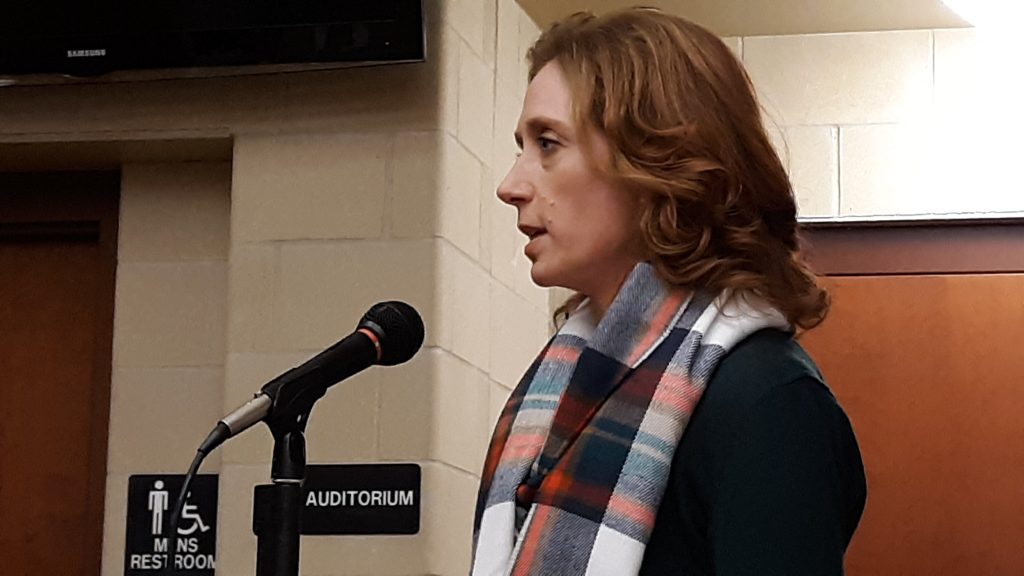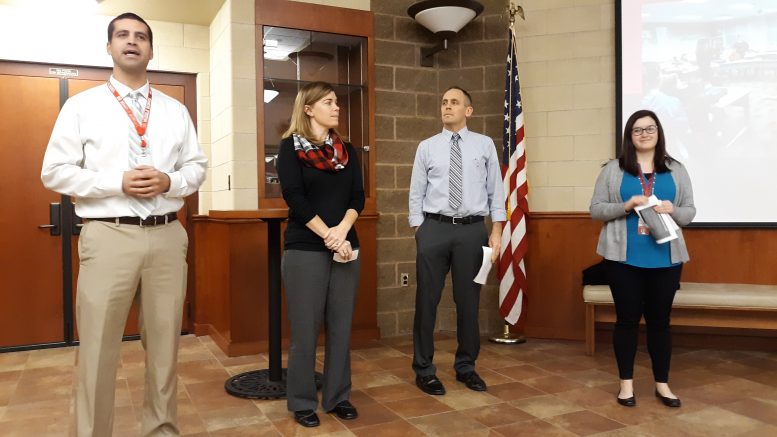By JAN LARSON McLAUGHLIN
BG Independent News
Being a middle schooler can be a tough time in the life of a kid.
They are full of angst, uncertainty, rebellion and a slurry of emotions.
To help students (and the adults around them) better survive those difficult years, the Bowling Green Middle School has a program called Reaching Every Child Through Advisory. The staff shared how the program works during the school board meeting last week.
Students meet weekly in small groups of 15 or so, and partner with teachers to help build relationships that go beyond the stress of getting good grades, said social studies teacher Pat Carney.
These weekly meetings give teachers a chance to monitor the social and emotional status of the students. Are some feeling depressed? Are some prone to violence in school?
For so long, teachers have wondered who would intervene with troubled kids, Carney said.
“Something has to be done,” Carney said teachers have realized for years. “We can’t wait anymore for somebody to do something.”
So the middle school program gives the students and teachers a chance to interact in a non-academic environment. If students establish positive relationships with their peers and adults, they will be better at handling the rocky young teenage years.
“We make every child feel they are valued and appreciated,” Carney said. “We believe in them and we value them.”
Some students just need to know that someone is listening and understanding them.
“It’s the reason we went into this profession,” Carney said.
Alyssa Santacroce, middle school guidance counselor, said the program allows students to talk openly about tough topics. They discuss how to manage their emotions, make responsible decisions, and show empathy for others.
“These are really important skills,” Santacroce said. “They are empowered in their decisions.”
A recent national study showed that students exposed to social-emotional learning programs fare better in the long run. They score higher in academic assessments and show decreased levels of emotional distress, Santacroce said. They also have increased rates of high school and college graduation.
The middle school program includes a second day each week, when the same small groups and same teachers are paired up to talk about the topics discussed earlier in the week. For example, if kindness and empathy are discussed on Tuesday, they will talk about putting those into action on Friday, health teacher Carey Schutte said.
They participate in teamwork activities, practice failure – which is an important part of learning – and create a climate where all the students feel connected, Schutte said.
Schutte conceded that it can be difficult to reach some students.
“Not every student was buying in right away,” she said. But gradually, they are making connections.
“It’s one kid at a time,” Schutte said. “Slowly but surely, we’re making a difference.”
A survey taken earlier this month showed that 91 percent of the students felt they were safe and respected in school, felt connected with other students and adults, and felt valued by other students and adults at school.
Middle school principal Eric Radabaugh said surveys will be conducted with students and teachers at the end of the year to measure the success of the program.
“Stay tuned,” he said.
Board member Ginny Stewart commended the school staff for undertaking the program.
“I applaud you for doing this,” Stewart said. “This is such a critical time in a young person’s life.”

Also at the meeting, the district was awarded the Ohio Leadership Advisory Council District of the Year Award.
Marty Schloegl, who presented the award, noted the integrity and effectiveness of the district’s faculty.
“It’s a great accomplishment for Bowling Green City Schools to receive this award,” Schloegl said as he presented the award to Board of Education President Jill Carr.
Superintendent Francis Scruci complimented the teachers, curriculum department, administrators and staff for earning the state award.
“Being selected out of the entire state is quite an honor,” Scruci said.

In other business, secondary curriculum coordinator Jodi Anderson asked the board to consider switching back to the 5 p.m. meeting time for monthly board meetings. Earlier this year the board was asked to meet later in the evening to make it easier for members of the public to attend meetings.
However, Anderson said the later meeting time hasn’t seemed to draw more citizens to the board meetings.
“I haven’t seen a significant change in attendance,” she said.
Anderson said the 5 p.m. meeting time is helpful for school staff who have been on the job since 7 a.m.

But citizen Grant Chamberlain said it’s difficult for the public to make it to the 5 p.m. meetings.
The board agreed to return to the meeting time discussion at its next monthly meeting.

